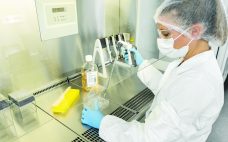One silver lining to the cloud of meeting only virtually has been our ability to “attend” some conferences to which we’ve not made it very often in the past. For example, I enjoyed tuning into the International Society of Pharmaceutical Engineers (ISPE) 30th Annual Aseptic Processing Conference, which was held virtually this past spring. It helped me plan for our September featured report, and it provided a good general update on the current state of biopharmaceutical formulation, fill and finish.…
Wednesday, December 8, 2021 Daily Archives
Modernize Your Gene Therapy Analytics with Automated Tools from Bio-Techne
This webcast features: Chris Heger, PhD, Director of Applications Science, Bio-Techne. Modern medicines call for modern technologies. Gene therapy is an exciting approach at work to cure diseases, where genetic material is delivered to a patient via a viral vector. This approach requires a doubly complex drug that contains both protein and oligonucleotides, and existing analytical tools just don’t meet the quantitative needs of these complicated therapeutic agents. In this webinar, hear how a variety of innovative analytical tools from…
The Green Imperative: Part 3 — Postuse Management of Single-Use Bioprocessing Materials, Today and Tomorrow
The world desires a more sustainable economy in which resources can be saved, products can be profitably used, and at the end of their useful life, component materials can be recycled into other useful products. The bioprocessing industry has made efforts to meet those goals and has learned a great deal about the role of plastic components in sustainable manufacturing. The most important lesson might be that a science-based approach is required to provide an accurate benchmark of manufacturingĘĽs environmental…
Patent Thickets Constrain US Biosimilars Market
Biosimilars represent a significant cost-savings opportunity in the United States because they can introduce competition for some of the most expensive and widely used prescription drugs on the market: originator biologics. Several market and regulatory barriers have slowed biosimilar market entry and uptake in the United States (1). Some hurdles are unintentional or transitory; others are deliberately crafted by manufacturers of reference biologics to thwart competition. Among the most significant strategic barriers to biosimilars’ entry into the US market are…
The Biosimilars Action Plan: Promoting Faster and More Extensive Adoption of Biosimilar Drugs
The pace with which biosimilar drugs have been adopted in the United States has frustrated (and displeased) policymakers (1). After passage of the Biologics Price Competition and Innovation Act (BPCIA) (2) as part of the Affordable Care Act of 2010 (3), policymakers intended and expected significant reductions in expenditures for this class of biopharmaceuticals (4). The Federal Trade Commission (FTC) had predicted that the percentage of savings would be lower than that of the <90% reduction in costs for small-molecule…
Nonideal Colligative Properties in High-Concentration MAb Solutions
Injectable-drug formulations for both subcutaneous and intravenous administration are designed to be consistent with the number of solutes present in human tissue. Such consistency with physiological conditions is achieved by adding an appropriate amount of salt and/or sugar to attain the desired tonicity. Care must be taken to prevent exposure of cells to either hypotonic or hypertonic formulations that could cause lysis or shrinking, respectively (1). Injection of formulations that deviate from human-plasma osmolality (295 mOsm) can cause pain upon…
Designing Vaccines: The Role of Artificial Intelligence and Digital Health, Part 2
In BPI’s October 2021 issue, part one of this review introduced the concepts of machine learning (ML) and artificial intelligence (AI), identifying some broad areas of application within vaccine discovery, preclinical testing, and clinical studies. This month, we conclude with a detailed discussion of specific disease targets and AI’s potential in addressing them. Having highlighted the example of Zika virus in part one, below we focus on malaria, tuberculosis, human immunodeficiency virus (HIV), herpesvirus, hepatitis, and pandemic coronavirus. Malaria Malaria…
Formulation, Fill and Finish of Lentiviral Vectors Part 2: Key Decisions and Risk Management
Over the past few years, Oxford Biomedica UK has developed and implemented its fill–finish platform at its 84,000-ft2 “Oxbox” manufacturing facility constructed in 2019. The first phase of development (45,000 ft2) houses four segregated suites for producing bulk viral-vector drug substance (VS) where closed systems and bioburden-control processes apply, and two fill–finish suites for viral-vector drug product (VP) in aseptic processing. The first of the fill and finish suites is expected to be approved in the first half of 2022.…
Finding the Right Partner for Outsourced Cell-Line Development
The successful commercialization of a biopharmaceutical product begins with a robust and productive cell line. Inefficient cell-line development (CLD) can lead to costly delays and roadblocks. For that reason, small, new, and virtual companies — and even established and mid-size companies — often seek the support of outsourcing partners to develop their cell lines. Outsourcing CLD activities can ease many pressures associated with manufacturing new biotherapeutics. The benefits of outsourcing CLD and associated processes include access to specialized expertise and…
Reducing Cell and Gene Therapy Development Time and Cost with New Purification Strategies
The past 40 years have ushered in the most advanced medicines the world has ever seen, with tremendous improvements in biomanufacturing technologies to enable their development. Advances in production technology have brought significant improvements in upstream productivity, which then caused bottlenecks in downstream processing. Although many bottlenecks have been resolved for most biologics, new modalities such as gene therapies and mRNA vaccines are driving the need for differentiated purification solutions. Meanwhile, pressures to increase efficiency and reduce costs continue to…










